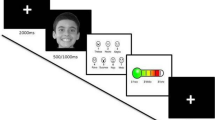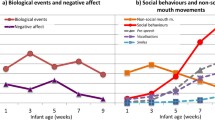Abstract
While observational studies of the emotional expressions of women and men have revealed several consistent patterns of gender differences, data pertaining to the emotional expressions of male and female infants are largely inconsistent. Attempting to trace the course of early emotional development in female and male infants, we undertook to compare the emotional expressions of boys and girls at 2 1/2 and 5 months of age in a variety of situations. All infants who participated in the study were from French-speaking Caucasian families of low and middle class. At each age level, infants were observed in a social and nonsocial situation. The social situation began with a mother—infant interaction, followed by a period during which the mother remained silent and still-faced. In the nonsocial situation, a mobile was presented and then removed. Infants' facial expressions were coded using the AFFEX system. Direction of gaze was also coded. Overall, boys' and girls' reactions were quite similar. At both ages, male and female infants spent more time looking at the toy than at their mother and showed more expressions of interest toward the toy. They also smiled more while interacting with their mother and displayed more negative expressions when facing their still-faced mother. One gender difference was found: At 2 1/2 months, girls smiled more than boys while interacting with their mother. Several explanations are proposed to account for these findings.
Similar content being viewed by others
References
Barrett, K. C., & Campos, J. J. (1987). Perspectives on emotional development II: A functionalist approach to emotions. In Joy D. Osofsky (Ed.),Handbook of infant development. New York: Wiley.
Bell, S. M., & Ainsworth, M. D. S. (1972). Infant crying and maternal responsiveness.Child Development, 43 1171–1190.
Bell, R. Q., Weller, G. M., & Waldrop, M. F. (1971). Newborn and preschooler: Organization of behavior and relations between periods.Monographs of the Society for Research in Child Development, Vol. 36.
Brody, L. R. (1985). Gender differences in emotional development: A review of theories and research.Journal of Personality, 53 102–149.
Brody, L. R., & Hall, J. A. (1993). Gender and emotion. In M. Lewis & J. M. Haviland (Eds.),Handbook of emotions. New York: Guilford Press.
Camras, L. A. (1992). Expressive development and basic emotions.Cognition and Emotion, 6 269–283.
Camras, L. A., Malatesta, C., & Izard, C. E. (1991). The development of facial expressions in infancy. In R. S. Feldman & B. Rimé (Eds.),Fundamentals of nonverbal behavior. Cambridge: Cambridge University Press.
Cossette, L., Ricard, M., Desrochers, S., & Décarie, T. G. (1993, March).Changes and continuity in infant emotional reactions to unfamiliar objects. Paper presented at the biennial meeting of the Society for Research in Child Development, New Orleans, LA.
Eagly, A. H., & Wood, W. (1991). Explaining sex differences in social behavior: A meta-analytic perspective.Personality and Social Psychology Bulletin, 17 306–315.
Ellsworth, C. P., Muir, D. W., & Hains, S. M. (1993). Social competence and person-object differentiation: An analysis of the still-face effect.Developmental Psychology, 29 63–73.
Feldman, J. F., Brody, N., & Miller, S. A. (1980). Sex differences in non-elicited neonatal behaviors.Merrill-Palmer Quarterly, 26 63–73.
Field, T., Vega-Lahr, N., Goldstein, S., & Scafidi, F. (1987). Face-to-face interaction behavior across early infancy.Infant Behavior and Development, 19 111–116.
Fish, M., & Crockenberg, S. (1981). Correlates and antecedents of nine-month infant behavior and mother—infant interaction.Infant Behavior and Development, 4 69–81.
Fish, M., Stifter, C. A., & Belsky, J. (1991). Conditions of continuity and discontinuity in infant negative emotionality: Newborn to five months.Child Development, 62 1525–1537.
Fogel, A., & Hannan, T. E. (1985). Manual actions of nine-to-fifteen-week-old human infants during face to face interactions with their mothers.Child Development, 56 1271–1279.
Fogel, A., Toda, S., & Kawai, M. (1988). Mother—infant face-to-face interaction in Japan and the United States: A laboratory comparison using 3-month-old infants.Developmental Psychology, 24 307–317.
Friedman, L. (1989). Mathematics and the gender gap: A meta-analysis of recent studies on sex differences in mathematical tasks.Review of Educational Research, 59 185–213.
Friedman, S. L., Jacobs, B. S., & Werthman, M. W. (1982). Preterms of low medical risk: Spontaneous behaviors and soothability at expected date of birth.Infant Behavior and Development, 5 3–10.
Frijda, N. (1986).The emotions. Cambridge, England: Cambridge University Press.
Gusella, J. L., Muir, D., & Tronick, E. Z. (1988). The effect of manipulating maternal behavior during an interaction on three- and six-month-olds' affect and attention.Child Development, 59 1111–1124.
Halberstadt, A. G. (1991). Toward an ecology of expressiveness: Family socialization in particular and a model in general. In R. S. Feldman & B. Rimé (Eds.),Fundamentals of nonverbal behavior. Cambridge: Cambridge University Press.
Hall, J. A. (1984).Nonverbal sex differences: Communication accuracy and expressive styles. Baltimore: John Hopkins University Press.
Hall, J. A. (1987). On explaining gender differences: The case of non-verbal communication.Review of Personality and Social Psychology, 7 177–200.
Hall, J. A., & Halberstadt, A. G. (1986). Smiling and gazing. In J. S. Hyde & M. C. Linn (Eds.),The psychology of gender: Advances through meta-analysis. Baltimore, MD: John Hopkins Press.
Haviland, J. J., & Malatesta, C. Z. (1981). The development of sex differences in nonverbal signals: Fallacies, facts, and fantasies. In C. Mayo & N. Healy (Eds.),Gender and nonverbal behavior. New York: Springer-Verlag.
Hay, D. F., Nash, A., & Pederson, J. (1981). Responses of six-month-olds to the distress of their peers.Child Development, 52 1071–1075.
Hubbard, F. O. A., & van Ijzendoorn, M. H. (1991). Maternal unresponsiveness and infant crying across the first 9 months: A naturalistic longitudinal study.Infant Behavior and Development, 14 299–312.
Hubert, N. C., Wachs, T. D., Peters-Martin, P., & Gandour, M. J. (1982). The study of early temperament: Measurement and conceptual issues.Child Development, 53 571–600.
Hyde, J. S. (1984). How large are gender differences in aggression? A developmental meta-analysis.Developmental Psychology, 20 722–736.
Hyde, J. S., Fennema, E., & Lamon, S. J. (1990). Gender differences in mathematics performance: A meta-analysis.Psychological Bulletin, 107 139–155.
Izard, C. E. (1983).The maximally discriminative facial movement coding system (MAX). (rev. ed.). Newark: Instructional Resources Center, University of Delaware.
Izard, C. E., Dougherty, L. M., & Hembree, E. A. (1983).A system for identifying affect expressions by holistic judgments (AFFEX). Newark: Instructional Resources Center, University of Delaware.
Izard, C. E., Hembree, E. A., & Huebner, R. R. (1987). Infant's emotion al expressions to acute pain: Developmental changes and stability of individual differences.Developmental Psychology, 23 105–113.
Kagan, J., Arcus, D., Snidman, N., Feng, W. Y., Hendler, J., & Greene, S. (1994). Reactivity in infants: A cross-national comparison.Developmental Psychology, 30 342–345.
Kaye, K., & Fogel, A. (1980). The temporal structure of face-to-face communication between mothers and infants.Developmental Psychology, 16 454–464.
Korner, A. F., Hutchinson, C. A., Koperski, J. A., Kraemer, H. C., & Schneider, P. A. (1981). Stability of individual differences of neonatal motor and crying patterns.Child Development, 52 83–90.
Lasky, R. E., & Klein, R. E. (1979). The reactions of five-month-old infants to eye contact of the mother and of a stranger.Merrill-Palmer Quarterly, 25 163–164.
Maccoby, E. E. (1990). Gender and relationships: A developmental account.American Psychologist, 45 513–520.
Malatesta, C. Z., Culver, C., Tesman, J. R., & Shepard, B. (1989). The Development of emotion expression during the first two years of life.Monographs of the Society for Research in Child Development, 54(1–2, Serial No. 219).
Malatesta, C. Z., Grigoryev, P., Lamb, C., Albin, M., & Culver, C. (1986). Emotion socialization and expressive development in preterm and full-term infants.Child Development, 57 316–330.
Malatesta, C. Z., & Haviland, J. M. (1982). Learning display rules: The socialization of emotion expression in infancy.Child Development, 53 991–1003.
Manstead, A. S. R. (1991). Expressiveness as an individual difference. In R. S. Feldman, & B. Rimé (Eds.),Fundamentals of nonverbal behavior. Cambridge: Cambridge University Press.
Matias, R., & Cohn, J. F. (1993). Are Max-specified infant facial expressions during face-to-face interaction consistent with differential emotions theory?Developmental Psychology, 29 524–531.
Mayes, L. C., & Carter, A. S. (1990). Emerging social regulatory capacities as seen in the still-face situation.Child Development, 61 754–763.
Moss, H. A. (1967). Sex, age, and state as determinants of mother—infant interaction.Merrill-Palmer Quarterly, 13 19–36.
Moss, H. A. (1974). Early sex differences and mother—infant interaction. In R. C. Friedman, R. M. Richard, & R. L. Van de Wiele (Eds.),Sex differences in behavior. New York: Wiley.
Moss, H. A., & Robson, K. S. (1970). The relation between the amount of time infants spend at various states and the development of visual behavior.Child Development, 41 509–517.
Osofsky, J. D., & O'Connell, E. J. (1977). Patterning of newborn behavior in an urban population.Child Development, 48 532–536.
Plomin, R., & Foch, T. T. (1981). Sex differences and individual differences.Child Development, 52 383–385.
Riese, M. L. (1986). Implications of sex differences in neonatal temperament for early risk and developmental environmental interactions.The Journal of Genetic Psychology, 147 507–513.
Roe, M., & Beckwith, L. (1992, May).Gender differences in infant smiling to mother and stranger at two and three months. Paper presented at the 8th International Conference on Infant Studies, Miami, FL.
Sameroff, A. J. (Ed.) (1978). Organization and stability of newborn behavior: A commentary on the Brazelton Neonatal Behavior Assessment Scale.Monograph of the Society for Research in Child Development, 43.
Scherer, K. B. (1986). Vocal affect expression: A review and a model for future research.Psychological Bulletin, 99 143–165.
Shields, S. A. (1991). Gender in the psychology of emotions: A selective research review. In K. I. Strongman (Ed.),International review of studies on emotion, Vol.1. Chichester, England: Wiley.
Stoller, S., & Field, T. (1982). Alteration of mother and infant behavior and heart rate during a still-face perturbation of a face-to-face interaction. In T. Field & A. Fogel (Eds.),Emotion and early interaction. Hillsdale, NJ: Erlbaum.
Sullivan, M. W., Lewis, M., & Alessandri, S. M. (1992). Cross-age stability in emotional expressions during learning and extinction.Developmental Psychology, 28 58–63.
Toda, S., & Fogel, A. (1993). Infant response to the still-face situation at 3 and 6 months.Developmental Psychology, 29 532–538.
Weinberg, M. K. (1992, May).Boys and girls: Sex differences in emotional expressivity and self-regulation during early infancy. Paper presented at the 8th International Conference on Infant Studies, Miami, FL.
Author information
Authors and Affiliations
Additional information
This research was supported by fellowships from the Social Sciences and Humanities Research Council of Canada to the first author and by grants from the Natural Sciences and Engineering Research Council of Canada, and FCAR to A. Pomerleau and G. Malcuit. We thank Mathilde Brault, Nathalie Cormier, Martine Gaudreau, Pascale Gingras, Mylène Leblanc, and Diane Venne for their assistance in the collection of data and in the coding.
Rights and permissions
About this article
Cite this article
Cossette, L., Pomerleau, A., Malcuit, G. et al. Emotional expressions of female and male infants in a social and a nonsocial context. Sex Roles 35, 693–709 (1996). https://doi.org/10.1007/BF01544087
Issue Date:
DOI: https://doi.org/10.1007/BF01544087




